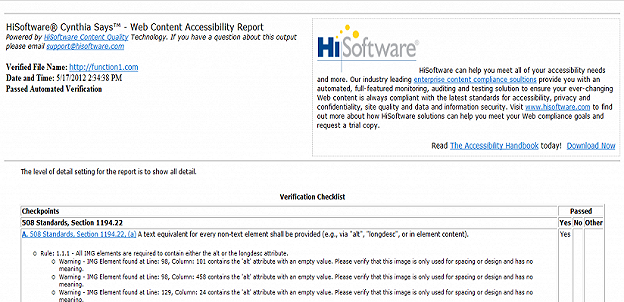Required Reading 4: Assessing Accessibility

Recently for a client, I was asked to lead the 508 accessibility testing efforts for multiple sites. When working on a government client engagement, 508 compliance is essential for any site deployment, software, web application, and hardware applications (computers, networks, peripherals, etc.) The legislation was put into place with the belief that if Federal agencies require accessible IT, then companies would offer accessible IT to the government and not have to create separate sets of products, rather they would just offer accessible IT for everyone within the same product.
With this new legislation, companies have started to build accessibility as an additional step into the development process making it easier to mitigate issues as they arise, rather than at the end of the development process.
So what exactly is section 508? The legislation, an amendment to the Workforce Rehabilitation Act of 1973, was signed by President Clinton in 1998, requiring all electronic and information technology that is developed by or purchased by the Federal Agencies be accessible by people with disabilities.
So what exactly does it mean to be “accessible”? Accessibility refers to technology that can be used effectively by people with disabilities as by those without. In October 1998, the 508 Access Board put together the Electronic and Information Technology Access Advisory commit (EITAAC) which was composed of representatives from industry, academics, government, and disability advocacy organizations who proposed standards for accessible electronic and information technology.
The 508 technical standards are comprised of technical and functional standards for web accessibility, which can be found on the Section508 website. These specific items must be accomplished during web site development to ensure that a person who is mobility impaired or blind can use the site. In addition to these technical standards, companies such as IBM and Microsoft have started to develop their own industry standards, referred to as the Web Accessibility Initiative, or WAI. WAI guidelines, which are generally grouped by priority, contain thirteen priority 1 items and numerous priority 2 and 3 items. Typically, all priority 1 items must be resolved prior to the release of your site or product to the Federal Government, with many agencies requiring the mitigation of priority 2 and 3 issues as well.
There are multiple ways to test the accessibility of your site. Web accessibility for toolbars such as Firefox or IE are helpful as well as programs such as Cynthia Says (http://www.contentquality.com/). It is vital to fix any problems with 508 compliance prior to delivery or completion of your project, and document all information regarding 508 compliance. Routine checks for 508 standards during development can help fix critical bugs and meet standards early on.
For more details on the 508 Accessibility standards, check out these other resources:
- Official Section 508 website: http://www.section508.gov/
- 508 Standards Guide: http://www.section508.gov/index.cfm?fuseAction=stdsdoc
- Accessibility Toolbars: http://wave.webaim.org/toolbar
- JAWS Screen Reading Software: http://www.freedomscientific.com/products/fs/jaws-product-page.asp
- Log in to post comments


